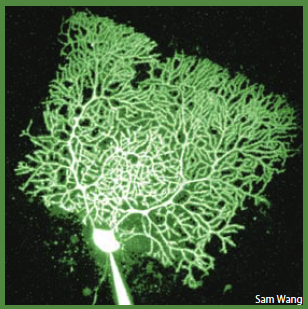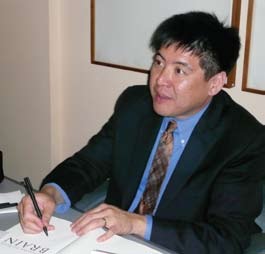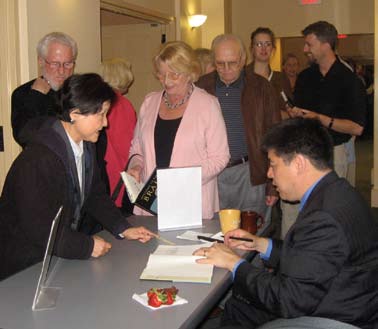 Cerebellum neuron, filled with fluorescent dye through glass pipet (projecting from bottom) and visualized using two-photon microscopy.
Cerebellum neuron, filled with fluorescent dye through glass pipet (projecting from bottom) and visualized using two-photon microscopy.
Image credit: Sam Wang
Princeton neuroscientist Sam Wang used the same title for his April 16 public lecture (watch below) at the KITP as for his new book, Welcome to the Brain, and the same provocative subtitle, Why You Lose Your Car Keys but Never Forget How to Drive and Other Puzzles of Everyday Life. The lecture, at least, could have as fittingly been called, “Welcome to the Brain: What It Thinks It Knows About Itself but Doesn’t.” As the above sample indicates, Wang has an uncanny knack for identifying misinformation about the brain.
Wang majored in physics as an undergraduate, and did his graduate work at Stanford in neuroscience. A recent article published in his undergraduate alumni magazine, Caltech News, reported on Wang’s transition from physics to biology: “One of the greatest challenges was replacing some of the intuitive approaches he had come to rely on in physics with different modes of thought. Another was the large mass of knowledge that had to be acquired. 'The field was a zoo — literally,' he says. Researchers have ‘accumulated a large body of information, but they’re still trying to find out the organizing principles behind it.’”
Those are key remarks for contemplating the marriage of physics and biology being consummated in KITP workshops such as “Anatomy, Development, and Evolution of the Brain,” from March 17 to April 25. Physics, as a mature science, is characterized as much (if not more) by a way of thinking that is profoundly quantitative, as it is by the content or accumulated knowledge of the field. In biology, details still matter a lot. Whether theory beyond Darwin and DNA will play a systematizing role analogous to its role in physics remains a great question.
In addition to his public lecture and attendant book signing, Wang served as one of five organizers of the KITP brain-design workshop. The other organizers were Ken Kosik of UCSB, Alexei Koulakov of Cold Spring Harbor, Greg Lemke of the Salk Institute, and Sara Solla of Northwestern University. Wang added, “Of course, we got lots of advice from [KITP permanent member] Boris Shraiman because he has lots of interest in the subject matter.”
The brain workshop, said Wang, “aimed to bring together several different threads in brain design and, more broadly, evolutionary biology and also theoretical physics in a way that had not been done before.”
“A very large fraction of the genes in the genome are expressed in the brain and not in other parts of the body.”
How have brains been optimized over the course of evolution to be very good at what they do? How have evolutionary forces and natural selection shaped brain architecture? Those are the overriding questions variously considered by the 69 brain workshop participants.
One approach to those questions, which comes from the core of modern neuroscience, aims to understand mechanisms of how brains and their components — neurons and glia — have developed. The first part of the workshop, organized by Lemke, focused on development issues.
Neurobiologists discussed processes that occur when, for instance, axons extend and become operational. (Axons are long, slender nerve fibers that conduct electrical impulses.) Discussion focused on the rules neurons use to grow and to extend, both at the molecular level as well as at the systems level, i.e., how circuits get hooked up in the developing brain.
 Photo by S.A. Solla.
Photo by S.A. Solla.
The second part of the workshop pondered how brains might be optimized — in the sense of using, so to speak, the least amount of wire or energy to do their job. “This is an area,” said Wang, “which attracts physicists and the area with which physicists who have started to work on neuroscience problems are likely the most familiar.” He describes a realm of research in which theorists look for minimization principles, and experimentalists design tools and techniques to reconstruct entire blocks of neuronal circuitry.
Neuroscientists call that block of neuronal circuitry a “neuropil,” a “pile” of connections between axons and dendrites all packed together in a seemingly solid mass of tissue. (Nerves are made up of two fibers, axons and dendrites, which protrude from the central cell body. Axons transmit, or send out, and dendrites receive neurotransmitters at synapses.) Tracing connections through a neuropil is a really hard problem. It’s like mapping electronic circuits on a chip, but in three- instead of two-dimensions.
The third part of the brain workshop focused on understanding the evolution of brains in the context of comparison with the brains of other species.
The three parts of the workshops — development, optimization/anatomy, and evolution — represent three approaches employed by three usually distinct sets of researchers to understanding the brain’s architecture. Integrating those approaches was the key aim of the workshop. Wang said that such an integrated approach was novel.
Wang’s expertise is in optical technologies for monitoring neuro-circuitry in the living animal. His laboratory specializes in a technique called “two-photon microscopy.” His research interests also include quantitative comparisons among species, particularly as related to the question of how brain structures scale up. As he explained that research question, “When you compare different species with each other, as brains get larger, what are the laws that govern how they scale up?"
“For me,” said Wang, “a large part of this workshop was learning about areas of research different from my own.”
One area is “the development of technologies for taking a block of tissue [the neuropil], cutting that tissue up section by section, and coming up with a detailed structure of that tissue.” Giving talks on their efforts to develop these technologies were Winfried Denk of the Max Plank Institute for Biomedical Optics, Sebastian Seung of MIT, and Dmitri Chklovskii of the Howard Hughes Medical Institute.
One of the difficulties with sectioning brains in the past, said Wang, “was reassembling the slices.” Winfried Denk has made a major innovation in this technique by taking pictures of a fixed block face of tissue as each slice is taken so that a series of pictures are created whose images are automatically in line with each other because the block doesn’t move.
“This is a very simple idea,” said Wang, “but technically difficult because of problems with exactly how you get an electron beam to generate a useful image under these conditions. There are little tricks that Winfried and his collaborators employ to get the technique to work.”
These technologies for making images of the brain generate huge databases, which in turn present a challenge for analysis. Some workshop participants are experts in automated recovery of structures. Their work, said Wang, promises to turn up significant finds in the next few years.
Another particularly exciting area of research looks at how nervous systems might be optimized from the viewpoint of developmental biological mechanisms — i.e., putting the viewpoints presented in parts one and two of the workshop together.
The human brain with 1011 connections and 1015 synapses runs on 12 watts of power. So, how does it accomplish all that it does in such a small space and with such a small energy budget? Answering that question is pivotal to understanding brain architectures.
Said Wang, “Developmental mechanisms are critical for understanding how one might have a system that makes itself optimal simply by the rules it uses at a cellular level to set up the whole system. The idea here would be that the genome determines cellular mechanisms, and these cellular mechanisms work to drive development, and those developmental mechanisms generate the organism."
“So, if you think that the organism is optimized in some way, then one logical step is to go back and understand the developmental mechanisms and look for those rules and see what those rules are that generated the system. These could be rules of how you generate a map, and rules for how you minimize the amount of wire that is used, and rules for how the system can teach itself things once it is born and comes into the world. These rules are ultimately driven by developmental mechanisms.”
Said Wang, “There is a whole field of biology called evolutionary and developmental biology, known to its proponents as ‘evo-devo,’ which has been thinking in this way about other body systems.”
The last week or so of the workshop brought an evolutionary perspective to brain development. Said Wang, “At the end, one thing that has been very interesting to me is doing analysis at the level of the sequence of proteins and genetic information to try to understand how genomes may have evolved, or to try to understand how proteins may have evolved."
“A very large fraction of the genes in the genome,” he said, “are expressed in the brain and not in other parts of the body.” There seems to be a lot of genome that is dedicated to coding the brain. Apparently, a lot of evolutionary effort with respect to the genome has gone into setting up this optimized brain. That evolutionary effort, in turn, indicates why, said Wang, “ is really important to join up ideas of optimization with ideas of development.”
 Full House. Neuroscientist Sam Wang signs a copy of Welcome to Your Brain for Dilling Yang with Alan Heeger (l) and his wife Ruth next in line. UCSB physicist Heeger won the 2000 Nobel Prize in Chemistry. Dilling’s husband, UCSB Chancellor Henry Yang, also attended the KITP public Lecture Wang gave. At such overflow events, first preference for seating goes to Friends of KITP.
Full House. Neuroscientist Sam Wang signs a copy of Welcome to Your Brain for Dilling Yang with Alan Heeger (l) and his wife Ruth next in line. UCSB physicist Heeger won the 2000 Nobel Prize in Chemistry. Dilling’s husband, UCSB Chancellor Henry Yang, also attended the KITP public Lecture Wang gave. At such overflow events, first preference for seating goes to Friends of KITP.
For all the emphasis on “optimization” as a key concept for understanding brains, Wang likens the evolution of the brain “to building an airplane after the plane has taken off. What I mean is that every generation of every species in the history of the diversification of animals has had to be well adapted to its niche; and so, as a result, there is some brain plan that was laid out fairly early in the history of vertebrates that if you look hard enough and deeply enough into a human brain, you can find vestiges of that old design. On top of it, other things got piled; and on top of them, other things.”
The evolutionary perspective tends to look at the brain in terms of innovating on a series of preexisting platforms — from the bottom up, so to speak. Optimization, by contrast, invokes a top-down perspective observing how well the brain works, and asking how and why.
These two viewpoints can inform each other, Wang said. “These fields — brain optimization and brain evolution — have previously not communicated much with one another. What the workshop aimed to do — and did do! — was to get the proponents of these views talking to each other.”
Why do we forget where we put our car keys, but remember how to drive?
In English, at least, we have but one word for “memory”; but Wang told his KITP public lecture audience, “Your brain has a half-dozen different memory systems,” and the system for driving is different from the short-term system for key recall. For a more detailed answer, see Welcome to Your Brain, co-authored with Sandra Aamodt, editor of Nature Neuroscience, and published March 2008.
